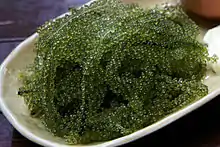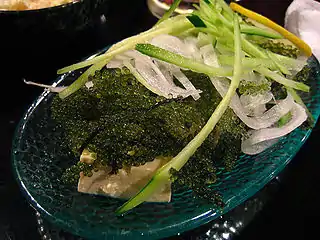Caulerpa lentillifera
Caulerpa lentillifera is a species of bryopsidale green algae from coastal regions in the Indo-Pacific. This seaweed is one of the favored species of edible Caulerpa due to its soft and succulent texture. It is traditionally eaten in the cuisines of Southeast Asia, Oceania, and East Asia. It was first commercially cultivated in the Philippines in the 1950s, followed by Japan in 1986. Both countries remain the top consumers of C. lentillifera. Its cultivation has since spread to other countries, including Japan, Vietnam, Taiwan, and China. C. lentillifera, along with C. racemosa, are also known as sea grapes or green caviar in English.[1]
| Caulerpa lentillifera | |
|---|---|
 | |
| Scientific classification | |
| Phylum: | Chlorophyta |
| Class: | Ulvophyceae |
| Order: | Bryopsidales |
| Family: | Caulerpaceae |
| Genus: | Caulerpa |
| Species: | C. lentillifera |
| Binomial name | |
| Caulerpa lentillifera | |
Commercial cultivation
Traditionally, C. lentillifera were harvested directly from the wild. The first commercial cultivation of C. lentillifera was in the 1950s in Cebu, Philippines, after accidental introduction of C. lentillifera to fish ponds.[2] Currently, there are around 400 ha of ponds in the Cebu, producing around 12 to 15 t fresh weight of C. lentillifera per year. They are usually harvested after two months from first planting, and every two weeks afterwards depending on growth rates.[3]
Commercial cultivation was followed by Japan in 1986, where it was cultivated in tanks in the warmer waters of Okinawa.[4] Commercial cultivation has since spread to other countries, including Vietnam, Taiwan, and China (in Fujian and Hainan). Most are for domestic consumption, but they are also exported to Japan.[5]
Culinary uses
Caulerpa lentillifera, along with C. racemosa, have been traditionally eaten in the cuisines of Southeast Asia, Oceania, and East Asia. They are almost always eaten raw on their own or in salads.[6] They have been described as tasting "like the ocean". It is known to be rich in iodine.[7]
In the Philippines, C. lentillifera is usually known as latô or arosep. After being washed in clean water, it is usually eaten raw as a salad (ensaladang lato), mixed with chopped raw shallots and fresh tomatoes, and dressed with a blend of fish sauce or bagoong (fish paste) and vinegar. Its popularity has also spread to the Malaysian state of Sabah (where it spelled latok) due to the migrations of the Bajau peoples.[8][3]
In Okinawa, Japan, it is known as umi-budō (海ぶどう), meaning "sea grapes", or kubiretsuta.[9] It is served dipped in ponzu, made into sushi, added into salads, or eaten as is.[10][11]
C. lentillifera is also eaten in Vietnam, where it is known as rong nho or rong nho biển, meaning "grape algae";[12] in Korea, where it is known as bada podo (바다포도), also meaning "sea grapes"; and in Indonesia (particularly Bali), where it is known as bulung.
Health benefits
Several health benefits have been reported for Caulerpa lentillifera including diabetes and lipid lowering properties.[13][14]
Gallery
_-_Philippines_1.jpg.webp)
 Umi-budō served Okinawan style
Umi-budō served Okinawan style
See also
- Eucheuma (Gusô)
- Nori
- Sea lettuce
References
- "Sea grapes - green caviar". Authentic World Food. Retrieved 14 April 2017.
- Trono, Gavino C., Jr. (December 1988). Manual on Seaweed Culture. ASEAN/UNDP/FAO Regional Small-Scale Coastal Fisheries Development Project.
- Dela Cruz, Rita T. "Lato: Nutritious Grapes from the Sea". BAR Digest. Bureau of Agricultural Research, Republic of the Philippines. Retrieved 26 October 2020.
- Trono, G.C., Jr. "Caulerpa lentillifera (PROSEA)". Pl@ntUse. PROSEA (Plant Resources of South East Asia). Retrieved 26 October 2020.
- Chen, Xiaolin; Sun, Yuhao; Liu, Hong; Liu, Song; Qin, Yukun; Li, Pengcheng (2019). "Advances in cultivation, wastewater treatment application, bioactive components of Caulerpa lentillifera and their biotechnological applications". PeerJ. 7: e6118. doi:10.7717/peerj.6118. PMID 30643691.
- Paul, Nicholas A.; Neveux, Nicolas; Magnusson, Marie; de Nys, Rocky (21 December 2013). "Comparative production and nutritional value of "sea grapes" — the tropical green seaweeds Caulerpa lentillifera and C. racemosa". Journal of Applied Phycology. doi:10.1007/s10811-013-0227-9.
- Ratana-arporn, Pattama; Chirapar, Anong (2006). "Nutritional Evaluation of Tropical Green Seaweeds Caulerpa lentillifera and Ulva reticulata". Kasetsart Journal - Natural Science. 40: 75–83.
- Wagey, Billy T; Bucol, Abner A (25 February 2014). "A Brief Note of Lato (Caulerpa racemosa) Harvest at Solong-on, Siquijor, Philippines". e-Journal BUDIDAYA PERAIRAN. 2 (1). doi:10.35800/bdp.2.1.2014.3793.
- Dawes, Clinton J. (1998). Marine botany. New York: John Wiley. ISBN 978-0-471-19208-4.
- "Umibudo Sea Grapes". Japan Visitor. Retrieved 26 October 2020.
- "All About Umibudo (Sea Grapes) - Where to Buy, Recipe, and More!". tsunagu Japan. Retrieved 26 October 2020.
- Jacobs, Ananda (April 22, 2014). "In search of the fruits of Okinawa's oceans". The Japan Times Online. Retrieved January 22, 2019.
- Sharma, Bhesh Raj; Kim, Hyun Jung; Rhyu, Dong Young (2015-02-15). "Caulerpa lentillifera extract ameliorates insulin resistance and regulates glucose metabolism in C57BL/KsJ-db/db mice via PI3K/AKT signaling pathway in myocytes". Journal of Translational Medicine. 13: 62. doi:10.1186/s12967-015-0412-5. ISSN 1479-5876. PMC 4350654. PMID 25889508.
- Sharma, Bhesh Raj; Rhyu, Dong Young (July 2014). "Anti-diabetic effects of Caulerpa lentillifera: stimulation of insulin secretion in pancreatic β-cells and enhancement of glucose uptake in adipocytes". Asian Pacific Journal of Tropical Biomedicine. 4 (7): 575–580. doi:10.12980/APJTB.4.2014APJTB-2014-0091. ISSN 2221-1691. PMC 4032834. PMID 25183280.
External links
| Wikimedia Commons has media related to Caulerpa lentillifera. |
- Lato, the strange sea salad The trade of the Caulerpa lentillifera in Coron, Philippines
- Guiry, M.D. & Guiry, G.M. 2013. Caulerpa lentillifera J.Agardh, AlgaeBase. National University of Ireland, Galway., accessed 19 February 2013.
- Caulerpa lentillifera, Seaweed Industry Association
